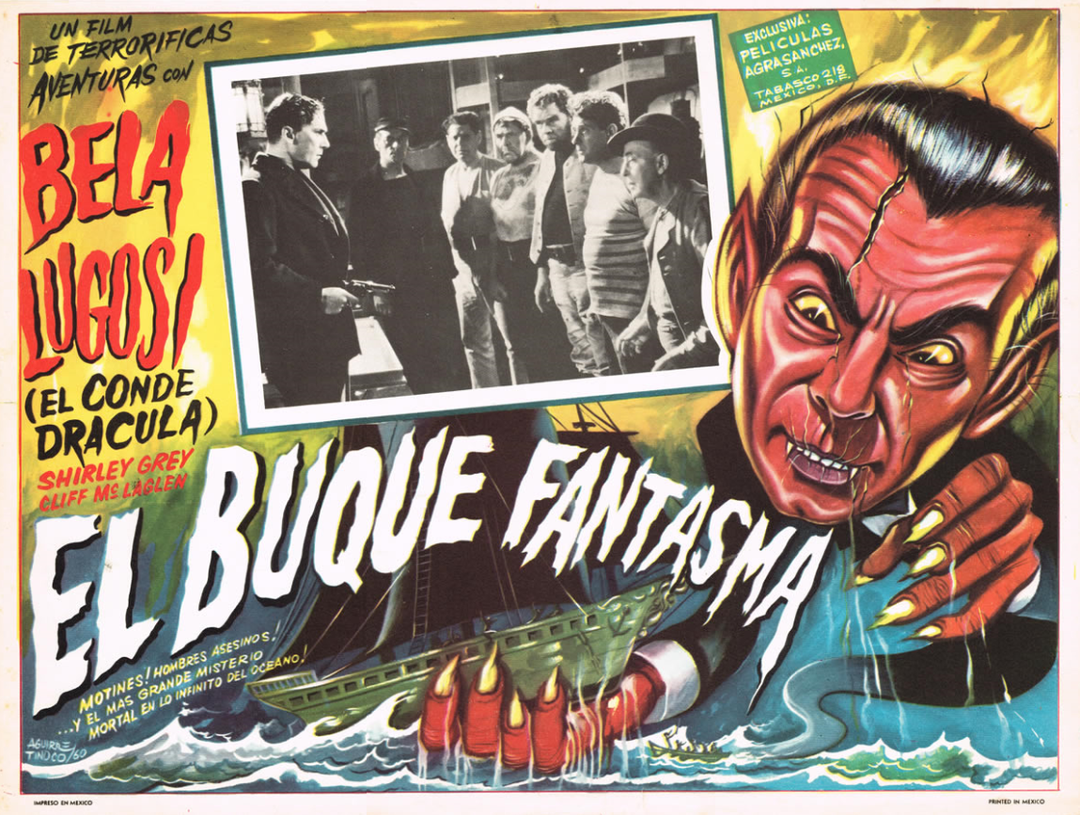Many of Hammer’s most celebrated works take place in a strange, lurid world of gothic shadows and macabre monsters. It is a world which may thrill and frighten audiences, but one that they can never hope to truly inhabit. The four individuals presented here represent the point at which our humdrum workaday world and Hammer’s world of romantic, grotesque horrors intersect. These are four people who, either through choice, illness or misfortune suddenly found themselves playing the leading role in a tale to terrify. Each would be perfectly at home in Hammer’s film canon, sandwiched between ghouls, vampires and all the other nasties we tell ourselves couldn’t possibly happen in real life…
Carl Von Cosel and The Love That Wouldn’t Die
© Wikimedia Commons
Much of Edgar Allen Poe’s work deals with themes of grief and the inability to let go of loved ones who have passed on. These are themes that run particularly deep within gothic fiction and the horror genre in general. Carl Von Cosel, born Karl Tanzler, exemplifies the tragic gothic hero, unable to reconcile himself to a world without his beloved. However, his obsession went beyond the romantic, and entered the arena of the macabre.
© Wikimedia Commons
Working on a tuberculosis ward in the 1930’s, Carl became obsessed with a beautiful new patient, Elena Hoyos, whom he vowed to cure of her affliction. Having lied his way into his position with 9 fabricated degrees, Von Cosel was in no position to be attempting to cure anyone, but Elena’s desperate family allowed him to try out his eccentric treatments. These included x-rays, herbs, chemicals and electric shocks.
© SquareSpace
Unfortunately, if unsurprisingly, he was unsuccessful and Elena died in October of 1931. Cosel arranged for her body to be preserved and interred in an expensive mausoleum. Her family were grateful, not realising that Von Cosel kept the only key, and would make nightly visits to Elena’s bedside, believing that she was communicating with him.
After losing his job, Cosel stole the corpse and took it to his home, where the unconventional couple shared a bed. Elena was kept “alive” using wire hangers to preserve her frame and rags, along with mortician’s wax and plaster of Paris to fill in the inevitable cavities of decomposition.
© MagsOnTheMove
Cosel would serenade her with organ recitals and attempt to resuscitate her through a variety of means, including a million vault tesla coil. Another attempt at revival saw him building an airship called the “Countess Elaine”. He claimed that it would take them both “high into the stratosphere, so that radiation from outer space could penetrate Elena’s tissues and restore life to her somnolent form”.
After a boy reported seeing him dancing with a “life-sized doll”, Cosel’s residence was searched by horrified policemen and he was arrested. Elena’s body, now little more than a plaster of Paris effigy with Elena’s real hair for a wig, was put on display for hundreds of members of the gawking public. Cosel would not go to prison for his crimes, which by then had passed the statute of limitations, but was denied his request to see his beloved again, consoling himself with a life-sized effigy made from Elena’s death mask.
© Wikimedia Commons Maria Vittorio del Pozzo and The Cursed Wedding
Tumblr
The spectre at the feast that casts a grim shadow over a happy occasion, dooming newlyweds to a short, unhappy marriage, has long been a recognizable trope. This plot device must have appeared very real to Prince Amadeo I and Maria Vittorio dal Pozzo, as their union was, to put it mildly, far from blessed. On May 30 1860, the couple were to discover that worse things can happen on your wedding day than simply forgetting the rings.
Although the day began with all the pomp and ceremony one would expect from the marriage of king of Italy’s son, it soon became clear that things would not all go swimmingly. For starters, instead of putting out the bridal gown, the bride’s wardrobe mistress was discovered hanging by her neck, quite dead.
© NY Daily news
Believing this inauspicious start to be the worst of it over, the bridal party set off for the venue but were delayed when the Colonel leading the party collapsed due to sunstroke, fell off his horse, and promptly died. With the body count already at two and a wedding to attend, the couple were no doubt anxious to press on. Unfortunately, they were held up when the gatekeeper was unable to open the gates for them, being, as he was, busy lying dead in a pool of blood.
As the day wore on the casualty toll continued to rise. It included the man who drafted the marriage contract (apoplectic fit) a stationmaster (dragged beneath the bridal train) and the best man (who shot himself in the head).
Deciding that perhaps the train was not the safest form of transport for the return journey, the wedding party decided to remain in their carriages and take the longer route home. Not to be outdone by steam technology, one of the horse-drawn carriages pulled the Count of Castiglione beneath itself. He was trampled to death by the horses, with one of his own medals piercing his heart in the process.
© 500px
If disapproving relatives and drunken best men are the worst things you have to deal with on your happy day, consider yourself lucky. When Maria Vittorio Del Puzzo tied the knot, guests counted themselves fortunate to have left with their lives.
John Hunter: The Mad Scientist
18th century surgeon John Hunter is no stranger to the horror genre, serving as inspiration for many genre staples, including Victor Frankenstein and Dr Jekyll. He has even been argued to have been inspiration, at least in part, for the novel Moby Dick, after performing an autopsy on a whale attended by Herman Melville. However, his wealth of peculiar habits and obsessions mean that he still has a lot of mileage left in him as a sinister character in a gothic film.
© Wikimedia Commons
Hunter was an early advocate of the scientific method in medicine. In fact, it’s probably fair to say that Hunter was the father of medicine in the sense that we understand the term today. He was one of the earliest doctors to really take apart and study the human body in order to truly understand it in mechanical terms. He was also mildly insane, in very entertaining ways (or, as we say in England "eccentric").
He was obsessed with deformity and with collecting the skeletons of deformed people. He would stalk circus and carnival performers with interesting abnormalities until they died and then buy their bodies, melt the skin off their bones and study their skeletons. An Irish giant named Charles Byrne was so scared of the devious doctor that he paid for his coffin to be lined with lead and dumped in the sea. Unfortunately for Byrne, a few well-placed bribes mean that he is now a prized exhibit in Hunter’s collection.
© BJ Winslow
The collection itself numbers over 14,000 specimens. These consist of neatly labelled and preserved human and animal parts, bodies and surgical equipment. This is particularly impressive when you consider that almost two thirds of the collection was destroyed by German bombs in World War 2. Naturally, the thousands of corpses purloined for Hunter’s research involved him intimately with England’s notorious “resurrection men” or grave robbers.
© Wordpress
In addition, Hunter had a house full of the most exotic animals he could find (again, when they died he dissected them or melted them down to skeletons). These included a giraffe and a panther that escaped into the village and had to be killed by a butcher. This chaotic menagerie and massive collection of pickled body parts makes Hunter’s London home the ideal backdrop for a spine-chilling adventure.
Traditionally, the mad scientist figure is laid low by his own hubris. This is certainly true in John Hunter’s case. Believing that he could cure syphilis, he gave himself syphilis. He couldn't cure it. He died.
Sarah Winchester and The Most Haunted House
© Alicosar
The traditional ghost story has always thrived on the “less is more” principle. It’s all about the creaking stair, the implied dread, the subtle menace. On the other hand, Hammer likes to push the envelope and think outside of the box - so what happens when that principle is turned on its head? If bigger is better, then we’ll need a giant house and a veritable army of ghosts. For that, we’ll need to head to 525 South Winchester Blvd, san José California, more commonly known as the Winchester Mystery House.
Inheriting 20.5 million dollars and nearly 50 percent ownership of the Winchester repeating rifle company would be any normal 1880’s person’s dream. Not so for the recently widowed Sarah Winchester, however, who believed that the windfall came with a sting in the tail - thousands of angry ghosts, all victims of Winchester weaponry.
© Doors to America
On the instructions of a spiritualist, the troubled Sarah Winchester moved west. Once there, she purchased the house she would sink her fortune into building continually for the next 38 years until her death in 1922. The building of the house seems to have served several supernatural functions. Firstly, it is an attempt at penance, the act of constantly building as a way of attempting to punish herself and make amends for the deaths caused by the company’s guns. Secondly, it provides a house for the presumably thousands of ghosts that Sarah Winchester believed were haunting her. Finally, occult touches to the architecture hint at some sort of imagined magical protection for Sarah. These include the repeated use of the spider web pattern in the architecture, as well as making sure that certain objects are kept in groups of 13. The house was intended to confuse and entrap the ghosts through these occult means, preventing them from reaching Sarah.
Certainly the building confuses the living. Seven stories tall at its largest (reduced to four stories by an earthquake) the Winchester Mystery House is a nightmare of twisted corridors, doors that open onto brick walls, staircases that lead nowhere and a wealth of secret passages and concealed rooms. Sarah Winchester was said to flit between the rooms through concealed passageways in confusing, circuitous route at all times in order to confuse any spirits that may have been following her.
© LivingOutsideoftheBox
A consummate host, Sarah Winchester allowed only three mirrors in the building (as she believed these angered spirits) and installed as many lights as possible, believing that ghosts were embarrassed by shadows, being unable to cast their own. Every night she would host a séance and every morning she would tell her foreman what new addition to the house the other side had advised. The result is a truly labyrinthine and eerie building, the perfect setting for a unique ghost story.

















